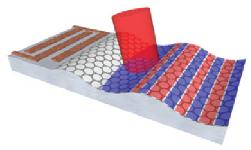
Campus Moncloa
Campus of International Excellence
Coupling light into graphene plasmons through surface acoustic waves
Researchers at the CIE Moncloa Campus have proposed a novel scheme for coupling laser light into graphene plasmons with the help of electrically generated surface acoustic waves (SAWs).
09/01/2014
Researchers at the Moncloa Campus within the Materials for the Future Cluster have proposed a novel scheme for coupling laser light into graphene plasmons with the help of electrically generated surface acoustic waves (SAWs).
Plasmons are electromagnetic waves confined to the interface between two materials and accompanied by collective oscillations of surface charges. The strong spatial confinement of the electromagnetic field and its coupling to charge carriers allow for the manipulation of light at subwavelength scales (beyond the diffraction limit of classical optics), opening the possibility to integrate electronics and optics at the nanoscale. Further promising plasmonic applications include single molecule detection, metamaterials, and light harvesting.

Graphene plasmons
In the novel scheme proposed at the Moncloa Campus, far-field radiation is converted into graphene plasmons by deforming the graphene sheet with a SAW and thus forming a tunable optical grating without the need of any patterning. A interdigital transducer (IDT) on a piezoelectric film is used to launch the SAW across the graphene sheet, as shown in the figure. By diffraction at the grating, incident laser light can overcome the momentum mismatch and excite plasmons in the graphene sheet. Moreover, plasmons can be switched electrically, via the high frequency signal at the IDT, whereas the plasmon resonance can be tuned via electrostatic gating. In addition, the IDT technology allows for many different plasmon functionalities. For example, curved IDTs can create interfering SAWs for plasmon focusing. Thus, SAWs offer the possibility to tailor electrically switchable graphene-based metamaterials.
This work has been led by Jürgen Schiefele (Departamento de Física de Materiales, UCM) and Jorge Pedrós (Instituto de Sistemas Optoelectrónicos y Microtecnología, UPM), together with Fernando Sols (UCM), Fernando Calle (UPM) and Francisco Guinea (CSIC). Support from the Marie Curie ITN NanoCTM, the Campus de Excelencia Internacional (Campus Moncloa UCM-UPM), ERC Advanced Grant No. 290846, and MICINN Grants No. FIS2008-00124, FIS2010-21372, TEC2010-19511, and FIS2011-23713 is acknowledged.
Tag: Materials for the Future Source: CEI Campus Moncloa
Event date:
09/01/2014
Press notices published by the American Physical Society and the Royal Society of Chemistry
Link to the original paper published in Physical Review Letters
